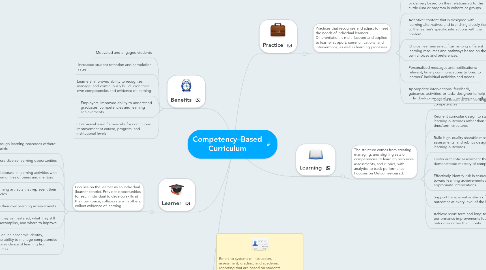
1. Learner
1.1. Focuses on the learner as an individual (learner-centric). Provides opportunities for each individual to develop skills at their own pace, collaborate with others, collect evidence of learning.
1.1.1. Progress through learning processes without time constraints
1.1.2. Explore diverse learning opportunities
1.1.3. Collaborate in learning activities with communities of peers and mentors
1.1.4. Create learning artifacts that represent their competencies
1.1.5. Reflect on their own learning achievements
1.1.6. See what they’ve mastered, what they still need to accomplish, and where to improve
1.1.7. Develop an online academic identity, including the ability to manage competencies and portable evidence of learning from multiple sources
2. Benefits
2.1. Motivated and engaged students
2.2. Increased student retention and completion rates.
2.3. Learners’ improved ability to recognize, manage, and continuously build upon their own competencies and evidence of learning
2.4. Employers’ improved ability to understand graduates’ competencies and learning achievements
2.5. Outcomes-based frameworks for continuous improvement at course, program, and institutional levels
3. Refers to systems of instruction, assessment, grading, and academic reporting that are based on students demonstrating that they have learned the knowledge and skills they are expected to learn as they progress through their education.
4. Practice
4.1. Practices that recognize and adjust to meet the needs of individual learners. Differentiation is multi-faceted and applies to learner support, communications, and interventions, as well as learning processes.
4.1.1. Prescriptive/Diagnostic: providing different learning materials or assessments to learners based on what they’ve already mastered.
4.1.2. Affiliation: learners receive different materials or delivery based on their relationship to the curriculum or program in cohorts or groups.
4.1.3. Adaptive: content that is designed with learning alternatives and branching closely tied to the learner’s specific interactions with the content.
4.1.4. Choice: learners select from among different learning resources and pathways based on their own choices and preferences.
4.1.5. Personalized messages and notifications: relevant, timely communications tailored to learners’ individual activities and needs.
4.1.6. Appropriate interventions: feedback, guidance, activities, or tasks designed to help individuals progress along their learning paths.
5. Learning
5.1. The structure comes from creating, managing, and aligning sets of competencies to learning resources, assessments, and rubrics, with analytics to track performance. Focuses on Outcomes-based:
5.1.1. Develop robust sets of learning outcomes and competencies
5.1.2. Reorient curricular design to start with learning outcomes rather than starting with time/term structures
5.1.3. Build high-quality sharable resources, assessments, and rubrics designed to support learning outcomes
5.1.4. Foster authentic assessment that includes demonstrated mastery of competencies
5.1.5. Effectively identify risk in students’ progress toward learning achievements and provide appropriate interventions
5.1.6. Support transparent analysis of learning outcomes at every level of the institution
5.1.7. Achieve short-term and long-term academic performance improvements focused on outcomes rather than inputs.
